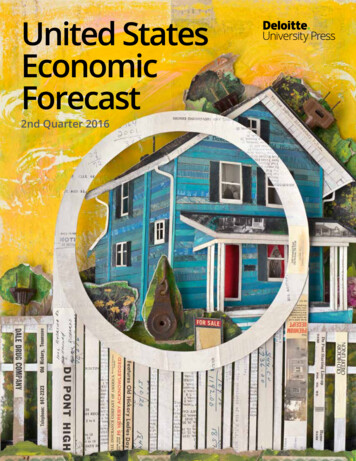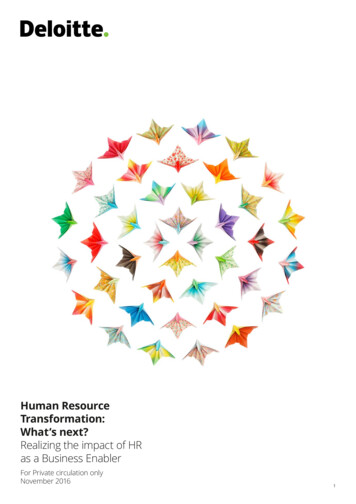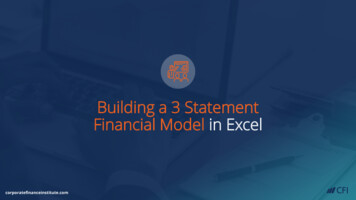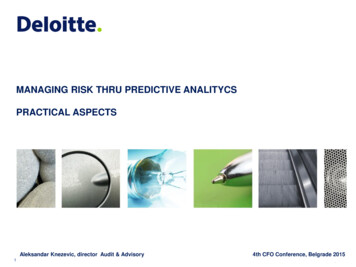
Transcription
United StatesEconomicForecast2nd Quarter 2016
United States Economic ForecastABOUT THE AUTHORSAUTHORDr. Daniel Bachman is a senior manager for US macroeconomics at Deloitte Services LP.CONTRIBUTORSDr. Ira Kalish is chief global economist for Deloitte Touche Tomatsu Limited.Dr. Patricia Buckley is director of economic policy and analysis for Deloitte Services LP.Dr. Rumki Majumdar is a macroeconomist and a manager at Deloitte Research, Deloitte Services LP.
2nd Quarter 2016CONTENTSUnited States Economic ForecastScenarios 24Sectors 5Consumers 5Housing 6Business investment Foreign tradeGovernmentLabor markets 8 9 10Financial marketsPrices 7 1213Appendix: Deloitte economic forecastContact information 19Additional resources 201 15
United States Economic ForecastUnited StatesEconomic Forecast2nd Quarter 2016As an economy fluctuates, so do economic measures. That may seem aninnocuous truism, but it’s amazing how often even experienced observers ofthe economy forget what it really means. When times are good, the rate ofeconomic growth might be high or even very high; in bad times, the economycan still sometimes register an upbeat quarter, at least according to the data.AND when the economy is growing moderately, as it has for the past few years?Fluctuations within the “normal” rangemean that in one month the economy might appear ready to burst out of its doldrums and, thenext month, about to plunge into recession—while most economists stick with their normalrange prognosis.and flattening of some measures of residentialconstruction. In a few months, those TV punditsmay well be talking about a new boom.This doesn’t mean that the US economy is allhearts, flowers, and unicorns. Stubborn problemspersist, such as: Foreign economic conditions continue to bea source of potential concern. China’s GDPgrowth increasingly seems to be held up by agrowing web of debt—and debt cannot continue to grow indefinitely.1 Exactly what mighthappen if China’s economy crashes is uncertain, but it would hardly strengthen the USeconomy. Meanwhile, Europe remains in theheadlines. The first quarter saw faster Euroarea GDP growth than in the United States,but the looming British vote on whether toexit the European Union creates ongoing uncertainty. And EU authorities are still workingto address issues with Greece.But pundits often find those monthly and quarterly shifts, however minor, irresistible material for discussion. After all, the talking heads on24/7 cable TV need to say something, and it’s a lotmore exciting to talk about doom and gloom—orthe excitement of a “new economy”—than to tellthe truth . . . which is that the economy is reallypretty boring right now.The end of 2015 and early part of 2016 saw quite abit of data to support the doom-and-gloom storyline; the 1 percent average GDP growth in Q42015 and Q1 2016 is undeniably sluggish. But twoquarters below trend don’t constitute a recession, and few people have seen much of an impact. Notwithstanding a disappointing monthlyreport in early June, job growth has remainedstrong despite a decline in industrial production Global monetary policy has entered a newphase. Some 23 percent of global GDP is nowbeing produced in economies with negativeshort-term interest rates, challenging economic analysts around the world.2
2nd Quarter 2016Figure 1. Real GDP growth(Percent)5Baseline4Coordinated globalrecovery3Continued slow rces: Deloitte/Oxford Economics.14Forecast161820Graphic: Deloitte University Press DUPress.comrent political leadership and institutions. It’sunclear what this means for economic growth,but at the very least, the electoral volatilitymay present business with higher-than-usualpolitical risks. Geopolitical conditions have been (relatively)quiet recently, but several wars in the MiddleEast, involving a confusing array of fightingfactions, threaten to pull in the major powers.Russia-Ukraine tensions may not be regularlymaking Western headlines, but skirmishescould escalate anytime. And these geopoliticalproblems could push up oil prices and createadditional challenges for policymakers andthe US economy (albeit some relief for a fewoil-producing countries and US states). If you thought that political uncertainty wasthe biggest factor holding back the American economy, however, consider this: US (andglobal) productivity growth remains very low,with no sign of an upturn, and experts haveas yet reached no consensus on why this isthe case. This slow growth contributes to difficulties addressing the country’s long-termbudget issues—and helps to suppress wages,perhaps exacerbating today’s political unrest. House and Senate leaders have reiterated thatthey intend on ensuring that the governmentis funded for the next fiscal year. However,they have had trouble putting those intentions into action. Following the abandonmentof budget resolutions, the normal appropriations process has stalled. Congress will likelyend up needing to pass a comprehensive “omnibus” reconciliation bill at the last minute,and fervent, obstinate political opposition tolast year’s budget compromise leaves openthe possibility of a government shutdown inthe middle of the presidential election.Beware of the too-easy statement that risk isgreater than in the past. Businesses faced extremely high levels of uncertainty in periods suchas the early 1970s (with the Arab oil embargo andtransition to floating exchange rates) and the financial crisis just six years ago. Today’s risks aredifferent, but they are hardly greater. The balanceof risks, however, looks biased toward things thatcould go wrong; that’s why Deloitte’s forecast Elections in Europe and in the United Statesindicate an unusual level of distrust with cur-3
United States Economic Forecastpanic. Several US financial institutions find themselves long on euro and China-related assets atthe wrong time. The result: a global financial crisis. Capital flows into the United States to avoidrisk in Europe and Asia, and the US dollar climbseven higher. The financial panic throws the USeconomy into recession. Timely Fed action offsets the financial crisis after several months,leading to relatively fast growth during the recovery.judges the potential risk of slower growth to begreater than the risk of faster growth.This doesn’t make for especially colorful banterbetween TV pundits. It does, though, create anenvironment in which well-timed and careful investment can still be profitable, and in which theprobability remains high that job growth and theeconomy will stay relatively healthy.ScenariosSlower growth (25 percent): Weak economicconditions abroad, financial turmoil, and flightfrom risky assets cuts demand below the levelrequired for labor market equilibrium. Althoughthe participation rate climbs slightly, hoped-forjobs disappear and the unemployment rate rises.Despite that increase, the Fed slowly raises interest rates, helping to keep a cap on inflation. GDPgrowth stays below 2 percent for the foreseeablefuture.There are plenty of reasons why actual economicgrowth might be better or worse than Deloitte’sforecasted baseline. Our forecast, therefore, includes four different scenarios to illustrate possible future paths of the US economy. Deloitte’sforecasting team places subjective probabilitieson each of the four potential scenarios.The baseline (55 percent probability): Weak foreign demand weighs on growth. US domestic demand is strong enough to provide employmentfor workers returning to the labor force for acouple of years, and the unemployment rate remains around 5 percent. GDP annual growth hitsa maximum of 2.5 percent. In the medium term,low productivity growth puts a ceiling on theeconomy, and by 2019, US growth is below 2 percent, despite the fact that the labor market is atfull employment. Inflation remains subdued.Coordinated global boom (15 percent): Terrorism, refugee problems, and political unrest proveto be only minor obstacles for European economies, and the continent finally begins to pull outof the doldrums. Emerging markets also pick upmomentum as China resolves its financial problems, and India and Brazil start to adopt morereforms. Capital flows out of the United Statesand into Europe and the developing world, pushing the dollar lower, further enhancing US exports. Continuing low US energy prices bolsterUS competitiveness. At home, the resolution ofbudget issues at both the federal and state levelsallows more money to flow into infrastructure investment, creating short-term demand and longterm productivity growth.Recession (5 percent): China’s financial problemscreate a drag on its economy, and growth slowssubstantially. This triggers a financial panic inEast Asia, as investors in countries connected bysupply chains to China seek to reduce risk. Volatility in Europe increases, as does market valuation of the riskiness of euro assets, adding to the4
2nd Quarter 2016SectorsConsumersmany remain “underwater,” with houses worthless than what the household owes on the attached mortgage. And there is the problem ofgrowing income and wealth inequality. (For abrief inequality discussion, see Ira Kalish’s 2011Deloitte Review article “Mind the gap.”2) The cur-AH, the US consumer—longtime supporterof the global economy, and still surprisingly resilient. Of course, consumers can’tspend money they don’t have, and their incomeslargely depend on having jobs. Over the last year,with only a few blips, job growth has picked up,with wages showing faint signs of rising too. Despite that, higher saving rates mean that US consumers have started sending a message to therest of the world: They cannot continue to playAtlas, holding the global economy on their shoulders as they did in the 2000s. Our forecast expects the US savings rate to settle in at just over5 percent; that is consistent with consumers’ behavior in the 1990s.rent presidential campaign, with its focus onworking-class concerns and fears, suggests thatinequality will be a focus of policy in the future.Many US consumers spent the 1990s and ’00strying to maintain spending even as incomesstagnated. After all, excitable pundits kept assuring them that the technology transforming theirlives would soon—any day now—make them allwealthy. But now they are wiser (and older, whichis another problem, as many Baby Boomers faceimminent retirement with inadequate savings).As long as a large share of the gains from technology and other economic improvements flows to aUS households face some obstacles in their pursuit of the good life. They have (mostly) recoveredfrom the overborrowing of the 2000s, though tooFigure 2. Consumer spending 4-8History9800020406081012Sources: Deloitte/Oxford Economics.14Forecast161820Graphic: Deloitte University Press DUPress.com5
United States Economic Forecastown households. But more than usual stayed putduring the recession: The number of householdsdidn’t grow nearly enough to account for all thenewly minted young adults. We expect thoseyoung adults would prefer to live on their ownand create new households; as the economy continues to recover, they will likely do exactly that—as previous generations have.relatively small number of households, overall USconsumer spending is likely to remain relativelyrestrained.CONSUMER NEWSReal consumer expenditures rose just 0.1 percent on average in the first three months of 2016but then jumped 0.6 percent in April. As incomescontinued to rise at a satisfactory rate, the savingrate was up to 5.9 percent by March before fallingback to 5.4 percent in April.This likely means some positive fundamentalsfor housing construction in the short run. Since2008, the United States has been building fewernew housing units than the population wouldnormally require; in fact, housing constructionwas hit so hard that the oversupply turned intoan undersupply. But the hole is smaller than thesefactors might suggest, due to factors offsettingeach other:Headline retail sales were slow until April, whena sudden and unexpected jump in April (1.3 percent, 0.8 percent less motor vehicles and parts)indicated that the slowdown was likely temporary. Higher gasoline prices are responsible forpart of the increase, but sales rose in almost allcategories. If household size returns to mid-2000s levels,we would need an additional 3.2 million units.Consumer confidence has fallen slightly off theend-of-year highs but generally remains elevated. Continued strong job growth and some stirrings of wage gains are likely keeping consumersbuoyant. On the other hand, household vacancy ratesare much higher than normal. Vacancy returning to normal would make available anadditional 2.5 million units—which wouldfill 78 percent of the pent-up demand forhousing units.Housing But are the existing vacant houses in the rightplace or condition, or are they the right type,for that pent-up demand? The future of hous-Every year, thousands of young Americans abandon the nest, happy to leave home and start their6
2nd Quarter 2016Figure 3. Housing(Million)(Percent change)2,200202,00015Housing starts(LHS)1,80010Residentialconstruction y980002040608101214-20Forecast1618Sources: Deloitte/Oxford Economics.20-25Graphic: Deloitte University Press DUPress.coming may look very different than in the past.Growth in new housing construction has beenconcentrated in multifamily units. If that continues, we may find it is related to young buyers’ growing reluctance to settle in existingsingle-family units.Tight housing credit may be a key culprit in keeping individual purchases of single-family houseslow, although there are some signs that credit isloosening. Young adults also seem to be showinga preference for living in urban rather than suburban communities. There may be some significant changes from the postwar model of singlefamily home ownership in store.In developing our housing forecast, we assumedthat the demand for housing (in the form of theaverage household’s size decreasing) picks up in2016, vacancy rates gradually drop, and household depreciation begins falling after new renters and buyers remove about 2.5 million housingunits from the nation’s housing surplus. Slowingpopulation growth suggests that we will have ashort-lived housing boom in which starts hit the1.3–1.4 million level, followed by a period of contraction until starts reach the level of long-rundemand. We estimate this to be about 1.0 millionunits in the medium term. Housing will likely contribute to GDP growth in 2016 but subtract fromGDP growth by 2018 as the pent-up demand goesaway. In the long run, the slowing populationsuggests that housing will not be a growth sector(although specific segments, such as housing forelderly residents, might well be very strong).3HOUSING NEWSHousing permits fell in the first few months of2016, although April saw a significant rebound.Much of the decline was in the volatile multifamily segment; single-family permits remainstable, although at a low number compared tothe pre-recession period. Housing constructionremains substantially below the level needed tomeet the pent-up demand for housing created bythe lack of construction since 2008.Contract interest rates have fallen about 30 basis points in the past six months. House pricesare rising very slowly—as of February, the CaseShiller home price index was about 5 percentabove the year-ago level.7
United States Economic ForecastBusiness investmentThe fall in oil prices has been a complicating factor in this positive outlook. Oil and gas extraction accounted for 6 percent of all nonresidentialfixed investment in 2013. That’s a hefty amount(considerably larger than the sector’s value addedshare), so shutting down new US oil explorationhad an immediate impact on investment. However, the big drop in the price of oil will surelyeventually affect the 94 percent of business investment that is unrelated to oil and gas extraction.Since the recession’s end, many have lamentedthe impact of political uncertainty on businessdecisions—specifically, on investment. In fact,relative to GDP, business investment has beenone of this recovery’s better-performing sectors.With strong profit growth, however, businessesmight well have invested even more. Many businesses are likely still waiting for assurance thatthey will have customers; once those customersreturn, there may be more reason to ramp up investment. Watch what businesses do, not whatthey say.BUSINESS INVESTMENT NEWSReal business fixed investment fell at a 5.6 percent annual rate in the first quarter (accordingto the first GDP release), the second consecutivequarter of decline. Both equipment investmentand structures investment fell, while intellectualproperty investment rose a subpar 1.7 percent.Other, more concrete factors are also weighing down investment. The rising dollar is notonly making US companies less competitive—it’scutting overseas earnings valued in dollars andtherefore reducing margins for US multinationals. And China’s slowing growth is exposing globalexcess capacity in many industries. In our baseline scenario, these factors help to moderategrowth and demand. In the “slower growth” sce-Nondefense capital-goods shipments—an effective high-frequency measure of equipmentspending—was flat over the first three months ofthe year. That’s an improvement over the end of2015. The less-volatile category of capital goodsless aircraft, however, fell in January and February and was flat in March.nario, they become important factors in keepingthe US economy below potential growth.Figure 4. Business sector(Percent)30Corporate profitsReal 0608101214Sources: Deloitte/Oxford Economics.Forecast161820Graphic: Deloitte University Press DUPress.com8
2nd Quarter 2016Figure 5. International trade(Percent)20( 0-209800020406081012Sources: Deloitte/Oxford Economics.14161820Exports (LHS)Imports (LHS)Merchandisetrade balance(RHS)-900,000Graphic: Deloitte University Press DUPress.comabroad tends to make the job of American exporters even harder.Private nonresidential construction grew in thefirst three months of 2016. Office constructionwas particularly strong (growing at an averagemonthly rate of over 3 percent). Commercial andmanufacturing construction grew more slowly.The cost of capital remains very low. Interest ratesfell from 4.0 percent for AAA corporate bonds atthe end of 2015 to just 3.6 percent by April 2016.Stock indexes picked up after February. Profitsremain at near record levels of national income.All of this amounts to a substantial headwind toUS GDP growth. Our baseline forecast shows realexport growth of around 2 percent for 2016 and2017, picking up to 5–6 percent afterward. Thecurrent account starts falling relative to GDP in2018 but remains over 2 percent for the entireforecast. Until growth in Europe picks up, it ishard to see trade contributing to US GDP growth.Foreign tradeForeign trade newsGlobally, the United States should be highly competitive. US unit labor costs have been falling andremain low despite the slowdown in productivity(as wages are stagnant, by and large). In a smoothly running global economy, the need for capitalin the developing world should help to keep thedollar at a reasonable level, and the internationalprice of US goods would be very attractive.US goods rose substantially in April after fallingin March. This may indicate that the decline inexports that began in late 2014 is reaching itsbottom. Overall imports rose in April but madeup less than half the ground lost in March. Theoverall trade balance was slightly lower in Apriland March than it was in November–February.The dollar has been falling against most majorcurrencies, with a rise in the euro since Februaryas the exception. At 1.13 (as of early June), theeuro is still quite cheap. European GDP growthThe global economy, alas, is not functioning well.The high US dollar has more than offset fallingAmerican unit labor costs, as global investorsseek security in US assets. And weak demand9
United States Economic Forecasthas been surprisingly strong, although industrialproduction remains weak.However, pressures from entitlement spendingare expected to keep the lid on future increasesin federal government demand.The Chinese economy is recording satisfactory growth, though many observers remainconcerned about the country’s financial systemand continuing infrastructure investment. Someanalysts focus on signs of strength in China’sconsumer and service sectors, suggesting along-awaited adjustment to becoming a consumer-driven economy. Others point to indicationsthat official Chinese figures may be implausiblyhigh. China’s future remains a large risk for theglobal economy.Congress, though, is far behind schedule on appropriations for the next fiscal year. There maybe a small prospect of yet another budget crisis,this one in the middle of the presidential electioncampaign. Our baseline forecast assumes thatcool heads will prevail and the federal government will remain funded through the end of theforecast horizon.After years of belt-tightening, most state andlocal governments are no longer actively cutting spending. They are getting some good revenue news from rising house prices and growingemployment, though low oil prices continue toweigh on the budgets of several states with largeoil-production sectors, and pesky pension liabilities continue to restrain state and local spending, The Congressional Budget Office estimates ashortfall of 2–3 trillion in state and local pensionfunding, and the need to fund these liabilitieswill likely keep a lid on state and local spendinggrowth.GovernmentUS government spending on goods and serviceshas been stagnant, and we expect little change inthe next few years. That’s actually an improvement from the 2010–13 period, when governmentcutbacks pulled down economic growth. In 2016,we are actually seeing a modest contributionof federal spending to GDP. That’s the result ofthe last federal budget agreement, which raisedcaps on both defense and nondefense purchases.Figure 6. Government sector(Percent)8History6ForecastAll governmentFederal4State and local20-2-4-6980002040608101214Sources: Deloitte/Oxford Economics.161820Graphic: Deloitte University Press DUPress.com10
2nd Quarter 2016Figure 7. Labor e (LHS)9100Average monthlyjob gain rces: Deloitte/Oxford Economics.14-400Forecast161820-500Graphic: Deloitte University Press DUPress.comGOVERNMENT NEWSshould help to bring people back into the laborforce.The federal deficit was about 25 percent higher inthe first seven months of FY2016 than in the sameperiod in FY2015. Outlays were up 4.4 percent,while revenues rose only 1.2 percent. Federal taxcollections in April 2016 were lower than expected, reflecting lower final payments for 2015 individual income taxes than authorities expected.But a great many people have been out of workfor a long time—long enough that their basicwork skills may be eroding. When the labor mar-DELOITTE LABOR FORCE PROJECTIONSIn the near term, the overall participationrate will likely be affected by two offsettingtrends. The aging of the population—inparticular, early Baby Boom cohorts reachingretirement age in the next five years—willpush down the participation rate. However,the poor labor market has driven downparticipation rates for younger workersas well, and the economic improvementin the forecast will almost certainly enticemany people in these middle-aged and,especially, younger cohorts to return to thelabor market.Government employment at all levels has beenessentially flat over the past few months.Labor marketsIf the US economy is to produce more goods andservices, it will likely need more workers, and thecurrently moderate wage growth is encouraging firms to increase capacity by hiring workers.However, many potential workers remain out ofthe labor force: They left in 2009, when the labormarket was terrible, and conditions apparentlyare still not good enough to entice most of themto return. Accelerating production will carry withit an eventual acceleration in demand for workers, along with a welcome mild rise in wages. ThatThe labor force projection in this forecastassumes that participation rates for theover-60s will remain at current levels andthat participation rates for the under-30s willreturn to their 1997–2000 average.411
United States Economic ForecastFinancial marketsket tightens, will those people be employable?Deloitte’s forecast team remains optimistic thatimprovements in the labor market will eventuallyprove attractive to potential workers and that labor force participation will pick up accordingly.Interest rates are among the most difficult economic variables to forecast because movementsdepend on news—and if we knew it ahead of time,it wouldn’t be news. The Deloitte rate forecast isdesigned to show a path for interest rates consistent with the forecast for the real economy.But the potential risk for different interest-ratemovements is higher here than in other parts ofour forecast.LABOR MARKET NEWSMonthly initial claims for unemployment insurance are holding steady, in the 260,000 range.Job openings continue to grow and, at almost 5.8million, are at the highest level recorded in thisdata. Quits (voluntary separations) fell in January,possibly because of seasonal reasons, but haveresumed rising. The high level of voluntary quitssuggests that labor demand remains strong.Global financial markets are now in a highly unusual state. About 10 trillion in sovereign debt isnow trading at negative interest rates (meaningborrowers are paying for the privilege of loaningmoney to these countries).5 The existence of negative interest rates is unprecedented, and the factthat even large countries (such as Germany) areborrowing on these terms indicates that globalfinancial markets have not fully recovered fromthe problems of the previous decade.Payroll employment growth dipped in April andcame in very low in May, bringing the threemonth average to just 116,000. The unemployment rate fell to 4.7 percent, but that’s becausethe participation rate has been falling; it remainsconsiderably lower than the average rate beforethe financial crisis, even adjusted for the age ofthe population. The forecast assumes this is within the normal variation of a growing economy.Despite this, the forecast sees both long- andshort-term interest rates headed up—maybe notthis week, or this month, but sometime in the future. The economy’s return to full employmentFigure 8. Financial markets7History6ForecastFederal funds rate10-year Treasury yield543210980002040608101214Sources: Deloitte/Oxford Economics.161820Graphic: Deloitte University Press DUPress.com12
2nd Quarter 2016FINANCIAL MARKET NEWSwould mean a return to “normal” short-term interest rates, though relatively slow growth willlikely keep a lid on longer rates in the mediumterm. The 10-year bond rate is set to rise but willlikely remain at relatively low levels throughoutthe forecast period.Although the Fed left interest rates unchanged inApril, minutes from the Open Market Committeemeeting suggested that members might be comfortable with a summer hike. The most recent“dot plots” suggest that the Fed will hike interestrates twice this year.But the most sophisticated observers of financialmarkets understand the most important thingabout interest rates: They fluctuate. This is thesector that is most likely to surprise us.Risk spreads jumped in early 2016. By February,the junk-bond spread over AAA bonds was 4.4percentage points. Since then, risk spreads havefallen as the stock market has picked up.The current baseline assumes that the Fed willraise interest rates once—in July—during the remainder of the year. While speculation on theprecise date of the next Fed hike has fluctuated with economic data—particularly with themonthly employment report—the overall forecastwould not significantly differ if the Fed hiked earlier or later, and raised rates two or three timesinstead of the assumed one time. The anticipatedimpact of each hike is relatively small (althoughthe cumulative impact may be large). And the exact timing is much less important for the economy than the overall trend and direction of ratechanges.Stock prices rose in March, fell in April, and rebounded somewhat in May, making up most ofthe ground lost in the December–February stockmarket correction.Bank lending remained healthy, with loans growing at an average rate of over 9 percent since thebeginning of 2016.PricesRemember the pundits who proclaimed loudlythat the Fed’s actions in 2009 would spark run-Figure 9. Prices(Percent)5CPI4Employment cost index3210History-19800020406081012Sources: Deloitte/Oxford Economics.14Forecast161820Graphic: Deloitte University Press DUPress.com13
United States Economic Forecastaway inflation? Likely, they’d rather you didn’t.Prices have been the most boring part of forecasting for the past six years, and there is littlereason to think that’s going to change.the 1970s. Bell bottoms, disco, and high inflationare likely all safely in our past (for now).Inflation is hard to come by when the labor market—which accounts for two-thirds of all costsin the US economy—has been so slack. Workers haven’t had leverage to obtain higher wageswhen prices go up, and businesses generally lackthe pricing power to cover higher costs. Instead,shocks from higher (or lower) energy or foodprices have dissipated into the ether rather thanbeing translated into sustained, higher inflation.Overall CPI growth remains low (1.1 percent overthe past year in April), although
United States Economic Forecast AUTHOR Dr. Daniel Bachman is a senior manager for US macroeconomics at Deloitte Services LP. CONTRIBUTORS Dr. Ira Kalish is chief global economist for Deloitte Touche Tomatsu Limited. Dr. Patricia Buckley is director of economic policy and analysis for Deloitte Services LP. Dr. Rumki Majumdar is a macroeconomist and a manager at Deloitte Research, Deloitte .










